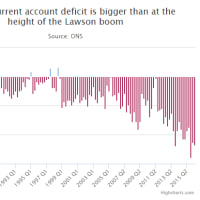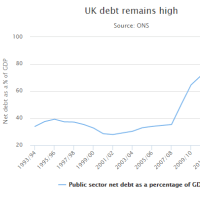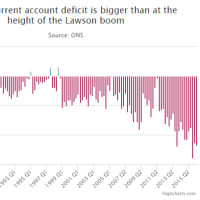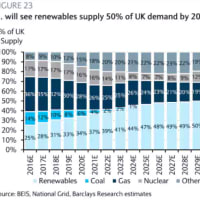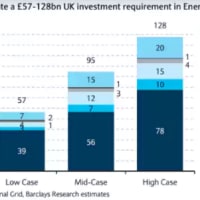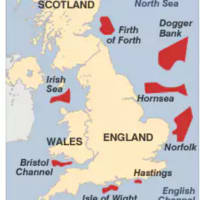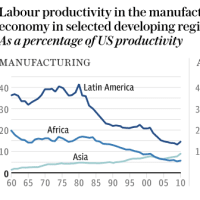Defiant BP says oil will not succumb to coal's fate in green revolution
(反抗児BP、石油は石炭の後に続かぬ宣言)
Ambrose Evans-Pritchard
Telegraph: 13 JUNE 2017 ? 7:19PM


(反抗児BP、石油は石炭の後に続かぬ宣言)
Ambrose Evans-Pritchard
Telegraph: 13 JUNE 2017 ? 7:19PM
Three cars parked directly in front of BP's headquarters in St James' Square this morning were plugged into electric charging sockets, poignant symbols of the green revolution sweeping global markets.
今朝、セント・ジェームス・スクウェアにあるBP本社の真ん前に停められた3台の自動車は、充電器につながれてしました。
国際市場を席巻するエコ革命の強烈なシンボルです。
The unveiling of the BP Statistical Review of World Energy is an annual ritual. This year it tells us that a profound rupture has occurred as technology advances by leaps and bounds, and humanity finds alternatives to fossil fuels faster than almost anybody thought possible.
BP統計の発表は毎年恒例の行事です。
今年は、技術が驚異的に躍進し、人類がほぼ全ての人が可能だと考えていたよりも遥かに迅速に化石燃料の代替物を発見したため、重大な決裂が起こったと伝えました。
Global carbon emissions were flat for the third year in a row, even though the global economy grew by 3pc. Coal is the chief casualty.
世界経済は3%成長したにも拘らず、世界の二酸化炭素排出量は3年連続横ばいとなりました。
石炭が主な犠牲となりました。
Whether the oil industry can keep the great changes at bay for another quarter century has become a hot question. Honda is the latest of the car giants to pirouette, and bet its future on electric vehicles (EV). The Japanese, German, and US car industries are now in locked in a cut-throat struggle for survival in the 2020s. All now suspect that the winners will not require much diesel or petrol.
石油業界がこの大きな変化をあと四半世紀食い止められるかどうかについて議論が巻き起こっています。
ホンダは意見を翻した最新の大手自動車メーカーですが、同社は社運を電気自動車に賭けました。
日本、ドイツ、米国の自動車産業は揃って2020年代の生き残りをかけた死闘を繰り広げています。
皆今では、勝者はディーゼルもガソリンも必要としないだろうと考えています。
Spencer Dale, BP's chief economist, expects EV penetration of 100 million vehicles by 2035. "It could easily be 200 million or 300 million, but it could also be less," he said.
BPのチーフ・エコノミスト、スペンサー・デール氏は、電気自動車は2035年までに1億台を突破すると予測しています。
「2億台、いや3億台も簡単だろうね。でもそれより少ないってこともあり得る」とのこと。
"Our central case is that oil demand will not peak over the next twenty years. Two billion people are being lifted out of low incomes and into middle incomes, and that will underpin oil," he said.
「石油需要が今後20年間にピークを迎えることはない、というのが僕らの主な理由。20億人が低所得から中所得にシフト中だろ。それが石油を支えるだろうね」
The arithmetic is that even 300m EV vehicles would displace just 3m to 4m barrels a day (b/d) of crude oil, against global consumption likely to be well above 120m b/d by then.
計算によると、電気自動車が3億台になっても一日あたり僅か300-400万バレルの原油が要らなくなるだけで、世界の消費量はその頃までに1.2億バレル/日を超える可能性が高いのだとか。
"Do I think that electric vehicles are coming? Yes, enormously quickly. Do I think that equals the dramatic demise of oil? No, I don't. The numbers just don't add up," he said.
「電気自動車がやって来ると思うかって?思うよ。めちゃくちゃ速く来るだろうね。それで石油が消滅すると思うかって?思わないね。計算が合わない」
That at least is the great hope of Big Oil. The nagging worry is what has happened to coal over the last three years. Three of the four top listed coal companies listed went bankrupt. Assumptions that China and emerging Asia would drive a secular rise in coal use years to come proved wildly wrong.
それは、少なくとも、大手石油会社の大きな期待です。
拭い切れない懸念は、過去3年間に石油に起こったことです。
石炭大手4社のうち3社が破綻しました。
中国とアジアの新興国が石炭利用を今後何年も増やしてくれるという前提は大いに間違っていたと証明されました。
"It feels to me like we are seeing a decisive break in coal relative to the past, and what has driven that is China. They have gone from 75pc rise in ten years to a fall for two years in a row. Wow," said Mr Dale.
「石炭について過去との決別を目にしている気がするのね。原因は中国。10年間で75%も増やしておいて2年連続減少だもん」とデール氏は言いました。
Some of China's retreat from coal is cyclical. The industrial economy slid into a deep downturn in 2015 and early 2016. Output of cement, iron, and steel all contracted, and this trio gobbles up a quarter of Chinese energy supply. There is likely to be a rebound of sorts.
中国の石炭離脱の一部は循環的なものです。
工業経済は2015年と2016年上旬に深刻な後退に見舞われました。
セメント、鉄鉱石、鉄鋼の生産が減りました。
この3つが中国のエネルギー供給の4分の1を大量消費していました。
或る種のリバウンドがありそうです。
But the shift from coal is largely structural. China has come off the boil. The economy will never regain its vertiginous double-digit growth rates. It is in any case switching from catch-up industrialisation to a service-led model that is less energy intensive.
とはいえ、石炭からのシフトは概ね構造的なものです。
中国はピークを過ぎたのです。
この国が眩暈のしそうな二桁台成長を再び遂げることは絶対にないでしょう。
いずれにせよ、中国はキャッチアップ型の産業化から、よりエネルギー集約型ではないサービス業主導のモデルに切り替わりつつあります。
China's decision-making body Politburo has been alarmed by the speed with which anti-smog protests have taken on the colouring of a mass opposition movement. It is moving fast to pre-empt this danger by shutting down the dirtiest coal plants in urban zones.
中国の意思決定機関である政治局は大気汚染抗議運動が大規模な反対運動のようになりつつあるスピードに警戒しています。
都市部で最も大気汚染の酷い石炭発電所を閉鎖してこの危険に先手を打つことすら出来ないスピードなのです。
While coal fell by 1.6pc in 2016, solar and wind power jumped by 33pc in a single year. China has vaulted past the United States to become the world leader in renewable energy. That said, the US was no slouch either. Its renewable use jumped 17pc, mostly from solar.
石炭が2016年に1.6%減少した一方で、太陽光と風力は1年で33%も急増しました。
中国は米国を追い抜き、再生エネルギーの分野で世界トップに躍り出ました。
とはいうものの、米国もなかなかです。
同国の再生エネルギーの使用は17%も急増しており、主に太陽光発電です。
What is remarkable is that a third of new primary energy worldwide last year came from renewables. Sceptics are quick to point out that the share is still just 4pc, but legacy effects are not what matter for forward-looking markets. It is new supply at the margin that sets prices and the patterns of investment.
驚くべきは、去年新たに得られた世界のプライマリー・エネルギーの3分の1が再生エネルギーだということです。
懐疑派は直ぐに、それでもまだたったの4%じゃないかと指摘しますが、将来を考慮する市場にとって大事なのはレガシー効果ではありません。
価格や投資パターンを決めるのは、限界での新規供給です。
Coal use plummeted by 8.8pc in the US. That is a different story. The mines of Colorado, West Virginia, and Kentucky have faced brutal competition from cheap shale gas. This is unlikely to change much whatever President Donald Trump tries to do to rescue the industry.
米国では石炭使用量が8.8%も激減しました。
これはまた別の話です。
コロラド、ウェスト・バージニア、ケンタッキーの炭鉱は安価なシェール・ガスとの無慈悲な競争にさらされています。
ドナルド・トランプ大統領が同産業を救済するために何をしようが、大きな変化が出る可能性は低いでしょう。
Britain's case is different again. Coal has gone through a full historic cycle. "Consumption is back to levels seen 200 years ago at the start of the industrial revolution," said BP.
英国の場合もこれまた異なります。
石炭は歴史的サイクルを一巡しました。
「消費は産業革命開始時、200年前のレベルに戻った」とBPは言っています。
The last three underground coal mines were closed in 2016. The power sector marked its first coal-free day in April this year. Over the past month, coal has averaged 2pc of UK electricity output.
2016年には地下炭鉱の最後の3つが閉鎖されました。
発電業界は今年の4月、初めて石炭フリーの日を迎えました。
この1ヶ月間、英国における石炭の発電量は平均2%です。
The Carbon Price Floor has done the trick. It shows that regulations can have a very powerful effect, though at a cost of raising electricity prices for industry and for those in energy poverty. "Prices really work in the energy market if you want to shift the fuel mix," said Mr Dale.
炭素の下限価格が効きました。
工業やエネルギーが不足している人々に対して電力価格を引き上げるという犠牲はあるものの、規制が強力な効果を持ち得ることを見せつけています。
「燃料ミックスを変えたいなら、エネルギー市場じゃ価格が本当に効果あるから」とデール氏は言いました。
Oil companies think themselves immune to this sort of assault for now, safely defended by the character of the transport fuel market. The great struggles are internecine, chiefly between US shale or 'tight oil' on one side, and OPEC on the other. BP thinks shale has proved to be the winner.
石油会社は、自分達は今のところこの手の攻撃にさらされない、輸送用燃料市場の性質によって安全に護られていると考えています。
死闘は内輪で、、主に米国のシェールまたは「タイト・オイル」とOPECの間で繰り広げられているものです。
BPは、シェールが勝者だと判明したと思っています。
"It has clearly lived up to its billing," said Mr Dale. He compares it to the child's toy, the Weeble. You can knock it over but it will not stay down. Shale has lower costs than many types of oil - contrary to widespread belief - and the efficiency gains in the Permian, Bakken, and Eagle Ford basins have been astonishing.
「看板に偽りなしだね」とデール氏。
彼は子供のおもちゃ、おきあがりこぼしになぞらえました。
おきあがりこぼしを倒すことは出来ても、寝かしておくことは出来ません。
シェールは多くの種類の石油よりもコストを下げましたし(広く信じられている内容とは異なり)、パーミアン、バッケン、イーグル・フォード盆地での効率化も驚愕すべきレベルです。
"Tight oil did not exist during the last oil price cycle and we are learning about it in real time," says BP. The saga has shown that operations can come back from the dead within three to four months. Well output from new rigs rose 40pc a year in both 2015 and 2016. A rig in the Permian produces three times as much today as it did in late 2014.
「タイト・オイルは前回の石油価格サイクルの時にはなかったし。今現実として学んでるところ」とBP。
この話は3-4ヶ月でオペレーションを復活させられるということを見せ付けています。
新しいリグの生産量は2015年と2016年に年に40%ずつ増加しました。
パーミアン盆地のリグは、2014年終盤の3倍の量を今日では生産しています。
Shale frackers come back fast and are a structural headwind for oil price rallies. Crude will stay lower for longer than it would have done under the old boom-bust investment cycle. The losers are those countries that require $80 or $90 a barrel to pay for their welfare states and balance their budgets.
シェール・フラッキング業者は急速に盛り返し、石油価格の反騰相場にとって構造的向かい風となっています。
原油はかつての投資循環の時よりも長い期間に亘って低価格となるでしょう。
負け組は、自国の社会福祉費用の支払いと財政均衡のために1バレル80ドルか90ドルにならなければならない国々です。
"Getting this down by $20 or $30 is enormously hard to do. They can't run fiscal deficits forever. I observe something that is not sustainable," said Mr Dale, who used to be the Bank of England's chief economist.
「これを20ドルか30ドル切り上げるのは恐ろしい苦労だから。永遠に財政赤字垂れ流しってわけにもいかないだろうし。なんか持続不可能なものだよね」とかつてイングランド銀行のチーフ・エコノミストを務めたデール氏は言いました。
Some Gulf states hope that the slump in oil and gas investment will eventually lead to a fresh price spike. BP estimates that spending is down $700bn to $900bn over the last four years. The effects will hit global crude supply in 2019, 2020, and 2021.
一部の湾岸諸国は石油ガス投資スランプが遂に次の価格急騰をもたらすことを期待しています。
BPの試算では、過去4年間で支出は9,000億ドルから7,000億ドルへ減少したとのこと。
その影響は2019年、2020年、2021年に世界の原油供給への打撃となるでしょう。
But even this may not play out according to the old script. "The technology is getting better and better, and we are finding more and more oil and gas. There is an abundance," said BP.
とはいえ、これですらも昔のシナリオ通りにならないかもしれません。
「テクノロジーはどんどん良くなってるし、石油もガスもまだまだ見つかってるし。いっくらでもあるもの」とBP。
In other words, the nightmare may be coming true for Saudi Arabia, Iraq, Iran, Russia, Venezuela, Nigeria, and other petro-nations. To misquote John Maynard Keynes, the price of crude can stay low for longer than many of them can stay solvent.
要するに、サウジアラビア、イラク、イラン、ロシア、ベネズエラ、ナイジェリア、その他産油国の悪夢が現実のものになるかもしれないわけです。
メイナード・ケインズの言葉をもじると、原油価格は彼らの多くがやっていける期間よりも長い期間に亘って安価であり続ける可能性がある、のです。











